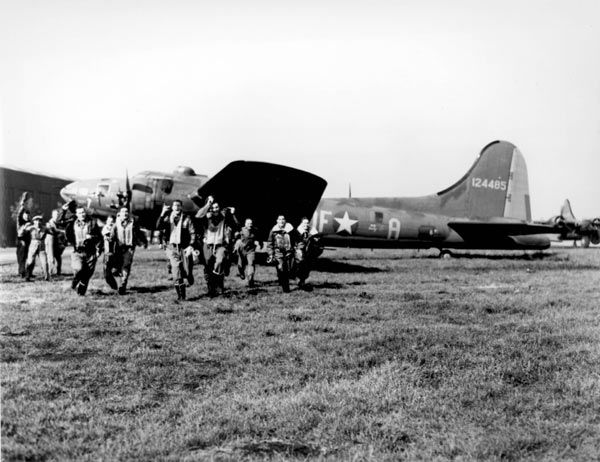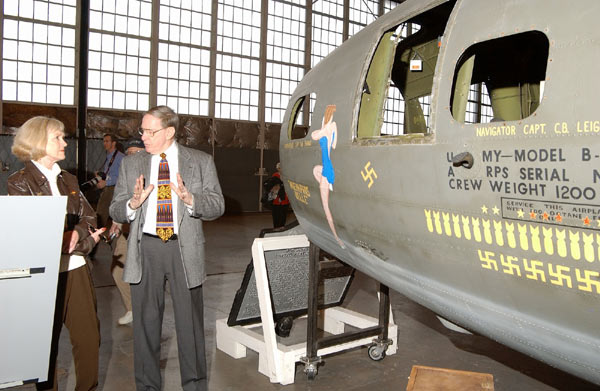RESTORATION OF THE MEMPHIS BELLE
It will take years to put this prize back in "Like New Condition" - Page 1

Memphis Belle and Crew, ctsy:NMUSAF
(B-17) Boeing B-17F-10-BO Flying Fortress Serial 41-24485, The Memphis Belle, 324th Bomb Squadron, 91st Bomb Group
Wartime history
The actual Memphis Belle, a Boeing-built B-17F-10-BO, serial 41-24485, was delivered in September 1942 to the 91st Bomb Group at Dow Field, Bangor, Maine. It deployed to Prestwick, Scotland, on September 30, 1942, and then to its permanent base at Bassingbourn, England, on October 14. Captain Robert Morgan's crew flew 25 combat missions with the 324th Bomb Squadron, all but four in the Memphis Bell: The Memphis Belle flew its 25th and last mission with a different crew on May 19, 1943, to Kiel, Germany. It was then flown back to the United States on June 8, 1943 by Morgan's crew for war bond
The plane was named for pilot Robert K. Morgan's sweetheart, Margaret Polk. The famous Petty girl nose art was painted by the 91st's group artist Tony Starcer.
Postwar historyThe crew of the B-17 "Memphis Belle" back from its 25th operational mission. All of the crew hold the Distinguished Flying Cross and the Air Medal. It all started with this Boeing B-17 Flying Fortress. In all of its missions, there was only one casualty, a leg wound to the tail gunner, June 1943.

Crew after 25th mission, ctsy:NMUSAF
After the war the Flying Fortress was saved from reclamation at Altus, Oklahoma by the efforts of the mayor of Memphis, the Hon. Walter Chandler, and the city bought the plane for $350. It was flown to Memphis in July 1946 and stored until the summer of 1949 when it was placed on display at the National Guard armory. It sat out-of-doors into the 1980s, slowly deteriorating due to weather and occasional vandalism. In the early 1970s another mayor had donated the historic plane back to the Air Force, but they allowed it to remain in Memphis contingent on it being maintained. Efforts by the locally-organized Memphis Belle Memorial Association, Inc. (MBMA) saw the aircraft moved to Mud Island in the Mississippi River in 1987 for display in a new pavilion with roof cover. It was still open to the elements, however, and prone to weathering. Dissatisfaction with the site led to efforts to create a new museum facility in nearby Shelby County. In the summer of 2003 the Belle was disassembled and moved to a restoration facility in Millington, Tennessee for work. In September 2004, however, the National Museum of the United States Air Force, apparently tiring of the ups and downs of the city's attempts to preserve the aircraft, indicated that they wanted it back for restoration and eventual display at the museum near Dayton, Ohio. On August 30, 2005 the MBMA announced that a consultant that they hired determined that the MBMA would not be able to raise enough money to restore the Belle and otherwise fulfill the Air Force's requirements to keep possession of the aircraft. They announced plans to return the aircraft to the National Museum of the United States Air Force near Dayton, Ohio after a final exhibition in Millington, Tennessee on September 30 - October 2, 2005. The Belle arrived safely at the museum in mid-October 2005 and was placed in one of the Museum's restoration hangars.
.jpg)
Memphis Belle restoration, (Wikipedia)
While the aircraft sat outside unattended, vandals and souvenir hunters removed almost all of the interior components. No instruments were found in the cockpit, and virtually every removable piece of the aircraft's interior had been scavenged, often severing the aircraft's wiring and control cables in the process. Through the efforts of the Memphis Belle Memorial Association, almost all of the removed items were replaced and corrosion of the metal was stopped. In addition, a coat of zinc chromate primer had been liberally applied to the aircraft's interior and throughout the inside of its wings to prevent further corrosion. All of this was done by volunteers donating time and money to this effort. Were it not for the MBMA's efforts and dedication,the NMUSAF would have a far greater challenge in the restoration of this historic aircraft. The Museum has placed restoration of Memphis Belle near the top of its priorities. In the magazine Friends Journal of the museum's foundation, Major General Charles D. Metcalf (USAF-Ret.), the director of the museum, stated that it might take 8-10 years to fully restore the aircraft.

Linda Morgan and Gen. Metcalf, ctsy:NMUSAF
| next page >> |